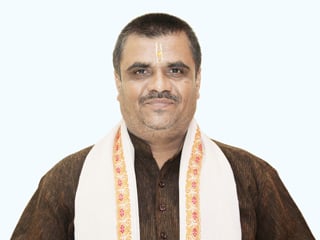
‘To test the chastity of Anusuya once the three Deities Brahma, Vishnu and Mahesh descended onto the earth. Due to Her prowess from penance, They were transformed into three babies. Out of the three babies, Shrivishnu assumed the incarnation of Shriguru Dattatreya.
The place where this occurred is called Shrikshetra Rakshobhuvan, a sacred place of pilgrimage of Deity Datta on the southern bank of river Godavari in the Beed District and Gevrai taluka of Maharashtra. With passage of time this place of pilgrimage came to be known as ‘Shri Rakshasbhuvan’.
1. Why is Shri Rakshasbhuvan known
as an first seat of worship of Deity Datta ?
Other seats of worship of Shri Dattaguru, for example Karanja, Mandgaon, Nrusinhwadi etc. are seats of human incarnations of Deity Datta and are famous in the name of the respective incarnations. But Rakshasbhuvan is the place of birth of Deity Datta, hence it is a seat of worship of Principle of Deity Datta. Therefore, is said to be the first seat of worship. It is famous as Varad (meaning blessing) Dattatreya temple because the three Deities Brahma, Vishnu and Mahesh had blessed Mother Anusuya at this place. As this is a nirgun (Non-materialized) seat, this temple does not have a kalash (Peak).
2. The attractive single headed Idol of Deity Datta in the temple
In the sanctum sanctorum of the Datta temple, is a beautiful, attractive single headed Idol made from sandstone, facing the east. A hooded serpent is located above the Idol. The right leg of this Idol is raised. The upper two hands of Shri Datta adorn a conch and a discus, the middle ones hold a small damru (Drum) and trident and the lower two hands hold a deepmala (Beaded chain used for chanting) and a kamandalu (Pot of an ascetic).
3. The Datta yantra
There is a Datta yantra located above the temple of Deity Datta. A yantra is a device associated with the nirgun (Non-materialized state) and attracts the nirgun Datta Principle from the environment into it. This is a very rare Datta yantra made of stone and shaped like an eight petaled lotus with a star in the center and has three parts – the Datta yantra is inscribed on the upper part, Shri Gurave namaha in the middle and Shri Varad Dattatreya in the lower part. This is unique as you will not find an Idol of Deity Datta with a yantra on the top of the head anywhere. It is the only one in the whole of Bharat with Datta yantra on its top.
4. Idol of Devi Annapurna adorning all weapons
Mother Annapurna co-exists wherever the mission of Datta goes on. Here too, She exists in the sagun (Materialized) form. In other places this Idol holds a spoon in Her hand. But here She is in the materialized form armed with all weapons.
5. Worship of Mother Annapurna in the temple
Every month on the full moon day, referring to Her as Mahakali, Mahalakshmi and Mahasaraswati, She is offered puran (Paste of gram lentil cooked with jaggery and coconut) and varan (Curry from tur lentil) as naivedya, seeking Her blessings. Even today, seekers or women experience a vision of the manifest form of Devi Annapurna after having rendered seva in the kitchen.
6. Spiritual experiences of seekers
and devotees during the procession of Datta Maharaj
Even today we can experience the blessings of Datta Maharaj and Mother Annapurna. When the procession of Datta Maharaj commences, the fragrance of chameli (Jasmine) and rose permeates the environment. At times, seekers or devotees hear the melodious sound of the platter and spoon which is heard when performing the ritual of sandhya. This venue is very effulgent and spiritually active.
7. Information on devotees of Datta
in the family of Mr. Nitin alias Yogiraj Maharaj Dole
The samadhi (Tomb) of our first ancestor, Sadguru Bhau Maharaj alias Dattaswami Dole is situated near the Holy feet of the Idol of Deity Datta. H.H. Bhauswami was born through a resolve, not through the birth passage. Therefore Gaubai aand Gopalswami were His parents in the worldly sense. He had long arms extending till the knees and ears till His shoulders. This attribute continued through Bhausaheb Maharaj, Antobadada, Dattaswami, Avdhutbuva, Keshavbuva, Rushikeshswami etc for seven generations. This changed in the 8th, 9th and 10th generations. As per our lineage, there was a tradition to have a son and two daughters on the seat. From the year Shak 1600 i.e. from Bhau Maharaj till our Guru this tradition continued as there was only one son in every generation. During that period, it was customary to have many children. Even then our family had only one son. I however, have two brothers and our family will now expand. The Maharaj of the peeth (Seat) performed spiritual practice such as annadan (Offering food), initiating spiritual practice with Gurumantra, creating disciples, following family traditions etc. Due to this, the sanctity of the place kept growing.
On the left of the Datta temple, that is to our right is the samadhi (Tomb) of the second generation Datta devotee of the Dole family, i.e. H.H. Babaswami alias Keshavswami, the son of H.H. Bhauswami. The upper part of that samadhi has a linga of Deity Shiva. There is an inscription on stone on the temple of the samadhi. To the left of this temple is a small covered path leading to the samadhi of H.H. Babaswami.
Five saffron samadhis from the Datta peeth belong to the devotees of Datta from Dole family. Saffron colour signifies detachment. Including the samadhis of H.H. Bhauswami and H.H. Babaswami there are in all seven of them. Samadhi of further three generations were not built as there were no such orders from the sect. I (Shri. Nitin alias Yogiraj Maharaj Dole) am the 11th descendant of the lineage of H.H. Bhauswami.
8. The only Shiva temple in Bharat without a Nandi
Beside the small temple leading to the samadhi of H.H. Bhauswami Dole, is a temple of Someshwar Mahadev. When Anusuya, the wife of Sage Atri, went Sati, Deity Shiva had arrived at the place without Nandi (Deity Shiva’s vehicle). Hence this is the only Shiva temple in Bharat without a Nandi.
9. Spiritual mission of Shri. Nitin alias Yogiraj Maharaj Dole
9A. Giving up the medical practice and commencing
spiritual mission as per the instructions of the Sadguru
My father happens to be my Sadguru. In 2008 He asked me for how much longer I would continue the medical practice. I practiced medicine for 16 years. No father will tell his son to give up his profession, but I realized that for me it was a command from my Guru. Therefore, I gradually stopped medical practice and commenced my spiritual mission. I further expanded the activities of the organisation. Within a year my father passed away. It was then that it dawned upon me why He had asked me to enter this field.
9B. Commencing study to understand the importance of the first peeth
Since 2009 entire responsibility for the organisation was on me. By then I had also stopped medical practice. Being a science student, I was very curious. I decided to study why this place was called an a first peeth not just listening to what was passed down by my ancestors. Therefore, I began reading, writing and studying the subject.
9C. Realisation that a place can acquire importance due to great personages
I travelled all over Bharat from Nepal to Kanyakumari and visited Datta seats of worship including Karanja, Gangapur, Pithapur, Narsobachiwadi and Mahur and performed as much spiritual practice as possible. Akkalkot, Shegaon, Narsobachiwadi and Kuravpur have acquired importance as seats of worship of Deity Datta due to the graeat Saints, Swami Samarth, Gajanan Maharaj, Nrusinha Sarswati and Shripad Shrivallabh respectively.
In the recent period H.H. Tembeswami discovered Karanja, Kuravpur and Pithapur and spread awareness about them because of which today these are recognized as a seat of Deity Datta. Before that no one was aware that Pithapur was the birthplace of Shripad Shrivallabh.
10. Dattaswami discovered the seat
of Datta in the region of Rakshasbhuvan
Even before that, in Shake 1600, 300 years before Nrusinh Saraswati, our first ancestor Dattaswami discovered Deity Datta’s place of worship in the region of Rakshasbhuvan and performed spiritual practice there. He commenced festivities on the birth anniversary of Datta which is continuing even today. All this is happening with the wish of Dattaguru, we have done nothing for this.

 Main places of pilgrimage of Deity Datta
Main places of pilgrimage of Deity Datta Datta Mandir at Shevgaon established by Yogatadnya Dadaji Vaishampayan!
Datta Mandir at Shevgaon established by Yogatadnya Dadaji Vaishampayan!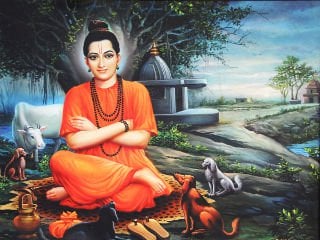 The spiritually active place of pilgrimage from Karnataka, Kuravpur which has become sacred by the...
The spiritually active place of pilgrimage from Karnataka, Kuravpur which has become sacred by the...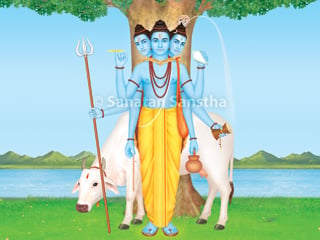 Spiritual reasons for the varying and same complexion of the trinity of Deities and also...
Spiritual reasons for the varying and same complexion of the trinity of Deities and also...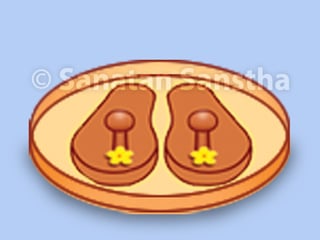 Datta Jayanti
Datta Jayanti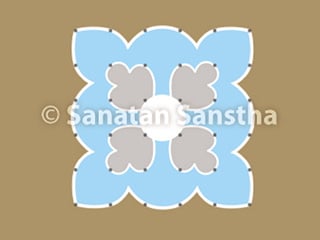 Rangolis to attract and emit Deity Datta tattva (Principle)
Rangolis to attract and emit Deity Datta tattva (Principle)